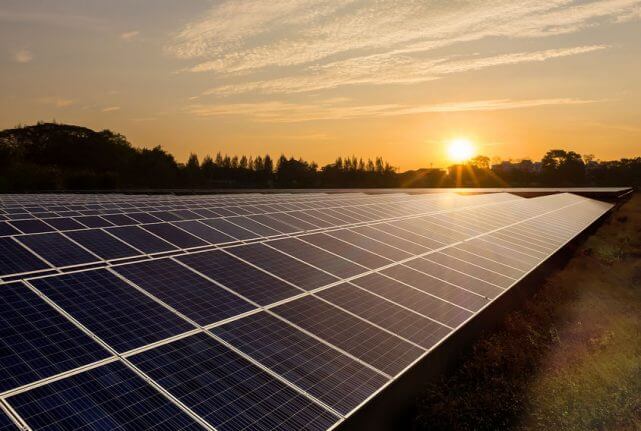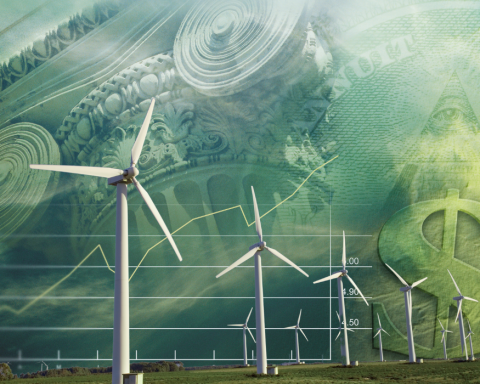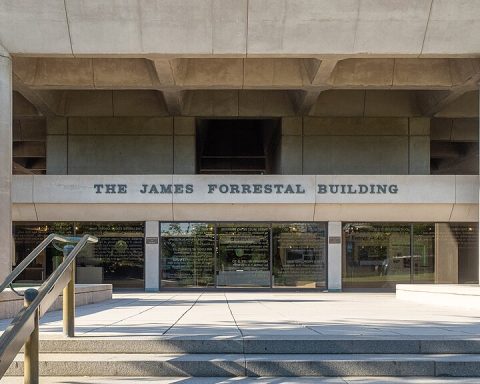As we shelter in place, the COVID crisis has brought Zoom into our homes, making it the “new normal” way to catch up with friends, family and coworkers. The same kinds of “new normal” innovations have been making their way into the electricity sector for some time – changing how power is generated and how it reaches our homes. These big changes are coming to the same grid we rely on to power our hospitals, keep in touch with loved ones and keep the food we eat safe.
When we turn our attention to how we will restore our lives and our economy when the pandemic passes, the future of the electricity system emerges as a key question. While we are becoming even more dependent on electricity, we have been reducing the greenhouse gas (GHG) emissions and air pollutants from power plants by phasing out the dirtiest of the generating stations, switching out coal for gas, and investing in efficiency, solar and wind energy. Still, the power sector remains a major source of GHGs and pollution in many parts of Canada, and electric vehicles and heat pumps are opening up vast new markets for electricity that could threaten the gains we have made. The post-COVID recovery presents a historic opportunity to make a final push for a fossil-free, renewable electricity system for all Canadians. What would it take?
Good news and bad news
Thanks to the legacy of Canada’s vast, hydroelectric resources, most of the power we generate is emission-free, on a nationwide basis. In fact, because we generate more power than we consume, the carbon-free portion of our generation is enough to cover more than 90% of our domestic electricity needs. That’s the good news. The bad news is that our electricity system is divided into regional and provincial silos that are well connected with their U.S. neighbours but not with each other. As a result, there are provinces with large surpluses of renewable hydropower right next door to provinces that are still dependent on coal-fired power plants for most of their electricity. To provide carbon-free electricity to all Canadians, it will be necessary to build new transmission links between the “hydro have” and the “hydro have-not” provinces.
In addition to improving access to the current surplus of hydropower that exists in some provinces, the complete decarbonization of Canada’s electricity supply will require expanding renewable electricity production. There is more good news here. Since 2009, the cost of wind and solar energy has declined by 70 and 89%, respectively. You’ll recall from our Build Back Better Homes and Buildings plan that the cost of Model T Ford automobiles plummeted by 80% between 1910 and 1920. One hundred years later, we’ve seen the same tumble in the costs of renewable energy, both propelling and propelled by a 14-times increase in global installed solar capacity – from 40 gigawatts (GW) in 2010 to 580 GW in 2019 – and a fourfold increase in global installed wind capacity over the same period – from 148 GW in 2009 to 594 GW in 2019.
In Canada, the physical supply of sun and wind energy isn’t a limiting factor in determining the role these energy sources will play in our energy future. Wind energy is now the cheapest source of new electricity supply, and solar is not too far behind. Once the purview of backyard hobbyists, billion-dollar wind and solar projects are now commonplace. The 400 MW Vulcan solar project under construction in southern Alberta will be the largest in Canada to date, and Canada’s largest wind farm is the 363 MW Seigneurie de Beaupré complex in Quebec. Before the onset of the pandemic crisis, clean energy was firmly established as one of the fastest growing and dynamic sectors of the global economy, and it will surely resume that position in the post-pandemic economy.
Greening the grid: Connectivity is key
Ensuring Canadian provinces have equal access to the benefits of the emerging clean energy economy will require improving the infrastructure for interprovincial trade in electricity. Canada is an east-west idea in a north-south continent, and nowhere is this more apparent than in the electricity flows across the U.S. border. At more than 60 billion kilowatt-hours (kWh) per year, exports of electricity to the United States dwarf interprovincial trade, and what interprovincial trade does take place is dominated by the flow of Labrador’s Churchill Falls power to Quebec, which is itself about equal to 75% of Quebec’s power exports to the U.S. In western Canada, Alberta and Saskatchewan rely heavily on fossil fuel generation while sandwiched between B.C. and Manitoba, both of which have nearly 100% carbon-free grids, with power to spare. In eastern Canada, Quebec and Newfoundland generate a large surplus of renewable electricity, most of which is exported to the U.S., while the Maritimes and Ontario face the prospect of continuing or increased reliance on fossil fuel generation as aging nuclear plants approach retirement.
There may one day be a national power grid in Canada, but long distances between generators and markets and the bane of asynchronous grids make that day far off. In the medium term, in the context of post-COVID economic recovery investments in clean energy, priority should be given to building new transmission links that have the highest potential for expanding Canadian markets for existing clean energy and leveraging growth in new renewable power investments. These projects take time to plan and build, but they are necessary elements of any effective strategy for a sustained recovery based on clean energy. We have included the following shortlist of indicative projects in our scenario for a carbon-free Canadian grid:
-
Add a 500 kilovolt connection between B.C. and Alberta to facilitate clean power flow to and from Alberta, $2–2.8 billion
-
Strengthen the intra-provincial grids in Alberta and Saskatchewan to facilitate the growth of wind energy supply, $1.3 billion (transmission only)
-
Add a new high voltage connection between Manitoba and Saskatchewan, $2 billion
-
Build an additional Nova Scotia/New Brunswick tie line to facilitate the flow of Quebec hydropower to the Maritimes, $500 million
-
Upgrade the current interconnection and build a new 2,000 MW high-voltage, direct current (HVDC) connection between Ontario and Quebec to facilitate the supply of hydropower to Ontario and to provide Ontario with access to seasonal reservoir storage in Quebec, $1.7 billion
Greening the supply: Tapping into Canada’s renewable cornucopia
To establish a reference level of carbon-free generation in Canada, we have added projects that are committed or under construction to the existing supply. This includes both the Site C hydro project in B.C. and the Muskrat Falls hydro project in Newfoundland and Labrador, as well as smaller planned additions to hydroelectricity generation in Manitoba and Alberta. As well, we have included wind and solar power projects that are underway or committed in most provinces, totalling an annual supply of 26 terawatt-hours (TWh). Depending on circumstances, these additions either displace fossil fuel generation or add to the surplus that is available for export or interprovincial trade. We also have assumed a reduction of 20 TWh per year to reflect the planned retirement of the Pickering Nuclear Station in Ontario. The net result is a reference level of 551 TWh of low-carbon electricity.
The new interconnections included in the above list allow increased supply of carbon-free electricity to Alberta, Saskatchewan, Ontario and the Maritimes. In the Maritimes and Ontario, the residual fossil fuel generation is relatively small and easily displaced with additional wind power and, in the case of Ontario, some refurbishment of aging hydroelectric stations. In Alberta and Saskatchewan, the feasible wind power potential (according to the GE Pan-Canadian Wind Integration Study) is not sufficient to completely displace fossil fuel generation, so further investments in solar farms were used to eliminate the remaining fossil fuel power plants.
All totalled, the scenario includes $8.3 billion for the transmission projects, $57 billion for 28.5 GW of wind capacity, $30 billion for 15 GW of solar capacity and $5 billion for storage facilities. Most of the storage is pumped hydro, and while it’s not fully modelled in this scenario, any stimulus measures should also be inclusive of additional hydropower potential to be reaped through upgrades and refurbishments. Annualized capital costs over the lifetime of the assets are in the range of $4.5 billion to $6.7 billion. By way of context, Canadian households, governments and firms already spend more than $60 billion per year on electricity. It’s envisaged that implementation of the scenario would extend over a 10year period, by which time the annual 75 Mt CO2e (carbon dioxide equivalent) of GHG emissions from the Canadian power sector would have been virtually eliminated.
This is only one scenario, but it is indicative of both the possibility for and the magnitude of a final transition away from fossil fuels in the Canadian electricity sector. When fully built out, it yields an annual carbon-free electricity supply of 625 TWh – 40 TWh above current domestic consumption levels. In order to focus on opportunities for federal economic stimulus investment, the scenario has focused narrowly on the supply side and the interprovincial trade in electricity, but there is an enormous potential to free up additional supply through efficiency gains in lighting and other electrical end uses, and through conversion of resistance heating to heat pump technology.
Finally, while investments in the bulk transmission system will help connect end users to centralized supplies of hydropower, seasonal storage, wind and solar farms, and local distribution systems are at the heart of the transition in the electric power sector. Electrification of buildings and vehicles, the growth of rooftop solar and other embedded generation (electricity production that is “behind the meter” in the traditional power sector), vehicle-to-grid storage, microgrids, 5G infrastructure, end-use efficiency gains and informatics, the changing out of inefficient electric resistance systems – all these things happen locally, wherever people live and work. In the post-COVID recovery period, the investments we make in local infrastructure and the built environment will determine how successfully we make the transition to a renewable and carbon-free electricity system. Opportunities for federal stimulus initiatives in this area range from green power procurement for federal facilities to investments in the acceleration of distributed power and smart grid systems.
Canada 2020–2030 Build Back Better Power Program
Recovering stronger by topping up our green power sources, storage and connections
The opportunity
We will continue to face many challenges in the coming weeks and months as the COVID-19 pandemic unfolds. As we work to “wake up” the economy in a safe and prudent manner, we should also be thinking about how we can build back better.
On average, Canada’s electricity grid is clean. Currently, 82% of electricity generation in Canada is carbon-free, and coal is set to be phased out by 2030 in Alberta and Saskatchewan. But for the moment, powering our electricity grid still results in air pollution, and after 2030 we will continue to see a rise in carbon pollution as gas plants replace coal power plants.
Saskatchewan and Alberta generated 82% and 91%, respectively, of their electricity from fossil fuels, split almost evenly between coal and natural gas, and Nova Scotia relies on coal for 60% of its power. Canadians living in these jurisdictions are exposed to air pollution that is harmful to their health, shortening lives by nearly a year, and now rivalling tobacco smoking for its negative health effects on society. Globally, the loweringof life expectancy from air pollution exceeds that by all forms of violence. Working together to clean up the air pollution caused by our grid is the right thing to do now.
Like the Building Back Better Homes and Buildings plan, the Building Back Better Power plan would deliver a strong triple benefit. Over 10 years, it would create 675,000 person-years of work, eliminate the 75 million tonnes of GHG emissions from the power sector and deliver better health to Canadians by reducing air pollution. A carbon-free grid across Canada would be achieved by:
-
investing in the transmission infrastructure needed for increased interprovincial trade between B.C. and Alberta, between Manitoba and Saskatchewan, and between Quebec and both Ontario and the Maritime provinces. This will expand markets for low-carbon power surpluses while providing flexibility for Alberta or other importing provinces to become power exporters in the future;
-
building the intraprovincial transmission capacity to ensure access to wholesale markets, thereby attracting investments in renewable energy, especially in the rich solar and wind regimes of southern Alberta and Saskatchewan; and
-
decreasing air pollution exposure and providing the backbone needed to grow the flow of renewable power.
These proposals are consistent with the plan we put forth last week. They go hand in glove to reduce demand for energy to heat our homes and workplaces, to convert the power for our cars from fossil fuels to electricity and to ensure that all provinces have clean electricity grids with the requisite capacity. The Build Back Better Power plan would create more and better jobs each year for a decade as more and more people, both young and experienced, learn how to deliver transmission projects. Such a plan would benefit the West and the Atlantic provinces in particular. In turn, these transmission projects would accelerate renewable energy investment, resulting in more jobs and significant progress in building out the renewable energy supply.
So let’s explore the power of power.
The proposal: Build Back Better Power
A 20% federal incentive of $1.7 billion in line with the value of GHG-emissions reductions for the first two years after the project is commissioneding would attract $6.6 billion in private investment, for a total of $8.3 billion to finance Canada Clean Power Transmission Lines.
The Canada Clean Power Transmission System (Canada CPTS), to be commissioned within five years, would in turn help attract $92.5 billion in private, co-op and Crown corporation-sector investment to scale up the renewable power needed to make all provincial grids 100%t carbon-free. Wind energy would require $57.1 billion to deliver 28.5 Gigawatts (GW) of new clean power capacity, mostly in Alberta and Saskatchewan. Solar energy would require an additional $30.3 billion to deliver 15.1 GW of power, again to be sited mostly in Alberta and Saskatchewan. Nova Scotia and Ontario would benefit from surplus power from neighbouring Quebec to eliminate coal in Nova Scotia and to eliminate the need for gas power plants to offset the retirement of the Pickering Nuclear Station.
Accelerating the commissioning of the Canada CPTS to 2025 rather than 2028 or 2030 would help put Canada at the forefront of the burgeoning global market for clean power. It would create 675,000 person years of employment over 10 years and deliver 75 million tonnes in GHG reductions annually over the same period. Perhaps most importantly, it would deliver clean air to Canadians in Nova Scotia, Saskatchewan and Alberta.
Steps for Build Back Better Power to fund the Canada Clean Power Transmission System
1. The Canada Infrastructure Bank (CIB), with support from the federal government, commits to funding for grants to buy down risk to bring parties together, including:
· $1.7 billion to buy the emissions reductions for the first two years of operations for elements of the Canada Clean Power Transmission System that are commissioned before 2025. These concessions would attract $6.6 billion in private investment and would bring provincial parties together with the necessary speed and efficiency. The goal of the Canada Clean Power Transmission System would be to help unlock $92.5 billion in private, co-op and Crown corp–sector investment for renewable energy.
2. Provinces only pay for new interties (interconnections permitting passage of current between two or more electric utility systems) in years they see value from them through federal Price Indexed Transmission Contracts. The CIB takes long term price risk of interties providing a mechanism in which the provinces pay for the interties only when they see value in the trade. In years they do not see value in the intertie, the CIB pays for the revenue requirement of the intertie. The CIB would in theory collect enough revenue in the years the interties are used frequently to pay for the years that they are not used as much. This will ensue the provinces are not at long term electricity price risk or stranded asset risk.
3. If the Federal Government or its crown corporation wants to “sell-on” this risk, it could possibly do so with a 45 year perpetual bond on which interest only is payable for the risk weighted net present value of the intertie revenue requirement.
Building intra- and interprovincial grid connections have been a “priority” for decades. Now is the time to bring parties together to build the backbone needed to attract investment at scale to deliver a zero-carbon grid by 2030. Doing so would reduce air pollution for many communities and would create 675,000 person-years of work. That’s the power of … power.
To learn more, explore our carbon free grid calculator:
Ralph Torrie is senior associate with Sustainability Solutions Group and partner at Torrie Smith Associates.
Céline Bak is the founder and president of Analytica Advisors.
With files from Toby Heaps, Aleena Naseem and Laura Väyrynen
Notice to reader: Please be aware some of the figures and other details in this white paper have been updated in the Final Report to reflect feedback.









